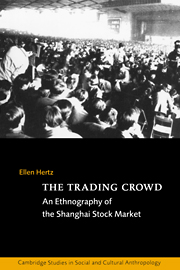Book contents
- Frontmatter
- Contents
- List of illustrations
- Preface
- Acknowledgments
- List of abbreviations
- Conversion rate
- Introduction: Ways and means
- Part I
- 1 First contact
- 2 The Shanghai stock market and the tributary state
- 3 Stock fever (gupiao re)
- 4 City people, stock people
- Part II
- Glossary of Chinese terms
- Bibliography
- Index
- More titles in the Cambridge Studies in Social and Cultural Anthropology series
2 - The Shanghai stock market and the tributary state
Published online by Cambridge University Press: 05 June 2012
- Frontmatter
- Contents
- List of illustrations
- Preface
- Acknowledgments
- List of abbreviations
- Conversion rate
- Introduction: Ways and means
- Part I
- 1 First contact
- 2 The Shanghai stock market and the tributary state
- 3 Stock fever (gupiao re)
- 4 City people, stock people
- Part II
- Glossary of Chinese terms
- Bibliography
- Index
- More titles in the Cambridge Studies in Social and Cultural Anthropology series
Summary
In 1992, the Chinese state was present in every aspect of the new market for shares in Shanghai, from the determination of which companies were to be transformed to the joint-share form of ownership, to the setting of prices for new share issues, to the regulation of the everyday workings of the Exchange. This fact of fundamental importance has been insufficiently acknowledged in studies of the Shanghai stock market (see Hertz 1996b). When it is acknowledged, the presence of the state is generally presented as a kink to be worked out, a problem to be resolved. Missing from this interpretive framework is a positive account of the role of state power in the market, that is, an account which explains why Chinese reformers designed their stock market they way they did. Such an account must link the structure and operation of the Shanghai market to the logic of the tributary state.
Regulating the primary market
Proposals for the use of a share-holding system to further industrial reform were circulated in China as early as 1980 (Bowles and White 1992:578). By the mid-1980s, faced with the sharp contrast between continued stagnation in state-run industry and growth in the reformed agricultural sector, the debate surrounding the use of joint-stock companies and financial markets took on a new urgency. After various attempts to “accomplish the key link” in structural economic reform (through profit retention, profit contracting, the factory director responsibility system, enterprise leasing, etc.), share-holding reform was conceived as a further and more thorough-going effort, even the last hope, toward the “enlivening of enterprise” (Wu 1988:60).
- Type
- Chapter
- Information
- The Trading CrowdAn Ethnography of the Shanghai Stock Market, pp. 44 - 70Publisher: Cambridge University PressPrint publication year: 1998



